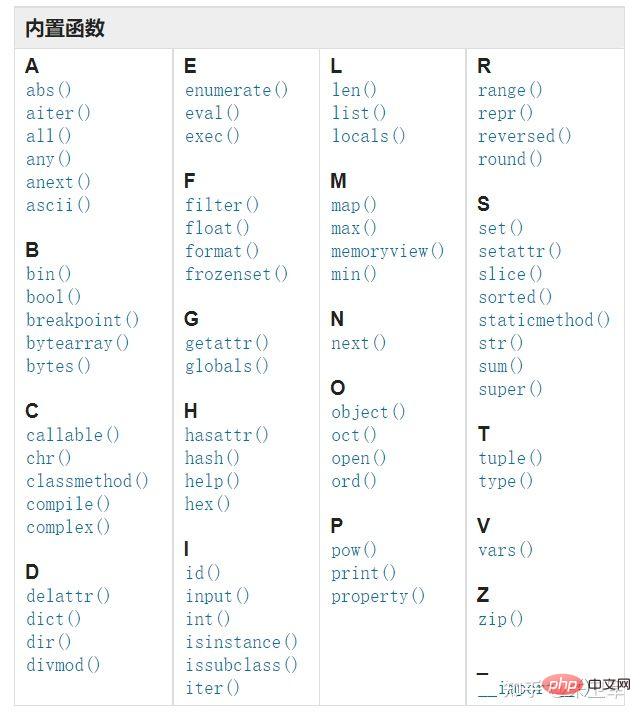
內建函數是python自帶的函數方法,拿來就可以用,比方說zip、filter、isinstance等

#下面是Python官檔給出的內建函數列表,相當的齊全

下面幾個是常見的內建函數:
enumerate()是python的內建函數,是列舉、列舉的意思。
對於一個可迭代的(iterable)/可遍歷的物件(如列表、字串),enumerate將其組成一個索引序列,利用它可以同時獲得索引和值。
在python中enumerate的用法多用於在for迴圈中得到計數。
seasons = ['Spring', 'Summer', 'Fall', 'Winter'] list(enumerate(seasons)) [(0, 'Spring'), (1, 'Summer'), (2, 'Fall'), (3, 'Winter')] list(enumerate(seasons, start=1)) [(1, 'Spring'), (2, 'Summer'), (3, 'Fall'), (4, 'Winter')]
zip() 函數用於將可迭代的物件作為參數,將物件中對應的元素打包成一個個元組,然後傳回由這些元組組成的清單。
如果各個迭代器的元素個數不一致,則傳回列表長度與最短的物件相同,利用 * 號運算符,可以將元組解壓縮為列表。
zip(iterable1,iterable2, ...)。
>>> for item in zip([1, 2, 3], ['sugar', 'spice', 'everything nice']): ... print(item) ... (1, 'sugar') (2, 'spice') (3, 'everything nice')
filter是將一個序列過濾,傳回迭代器的對象,移除不滿足條件的序列。
filter(function,data)。
function作為條件選擇函數。
比如說定義一個函數來檢查輸入數字是否為偶數。如果數字為偶數,它將傳回True,否則傳回False。
def is_even(x): if x % 2 == 0: return True else: return False
然後使用filter對某個清單進行篩選:
l1 = [1, 2, 3, 4, 5] fl = filter(is_even, l1) list(fl)
isinstance是用來判斷某一個變數或是物件是不是屬於某種類型的一個函數。
如果參數object是classinfo的實例,或是object是classinfo類別的子類別的實例, 傳回True。如果object不是給定類型的的對象, 則傳回結果總是False。
>>>a = 2 >>> isinstance (a,int) True >>> isinstance (a,str) False >>> isinstance (a,(str,int,list))# 是元组中的一个返回 True True
eval用來將字串str當成有效的表達式來求值並傳回計算結果。
表達式解析參數expression並作為 Python 表達式進行求值(技術上說是一個條件列表),採用globals和locals字典作為全域和局部命名空間。
>>>x = 7
>>> eval( '3 * x' )
21
>>> eval('pow(2,2)')
4
>>> eval('2 + 2')
4
>>> n=81
>>> eval("n + 4")
85
在日常程式碼過程中,其實有很多常用的句式,出現頻率非常高,也是大家約定俗成的寫法。
format把字串當成一個模板,透過傳入的參數格式化,非常實用且強大。
# 格式化字符串
print('{} {}'.format('hello','world'))
# 浮点数
float1 = 563.78453
print("{:5.2f}".format(float1))
使用 連接兩個字串。
string1 = "Linux" string2 = "Hint" joined_string = string1 + string2 print(joined_string)
Python 條件語句是透過一條或多條語句的執行結果(True 或 False)來決定執行的程式碼區塊。
其中if...else語句用來執行需要判斷的情形。
# Assign a numeric value
number = 70
# Check the is more than 70 or not
if (number >= 70):
print("You have passed")
else:
print("You have not passed")
迴圈語句就是遍歷一個序列,循環去執行某個動作,Python 中的迴圈語句有 for 和 while。
for循環:
# Initialize the list
weekdays = ["Sunday", "Monday", "Tuesday","Wednesday", "Thursday","Friday", "Saturday"]
print("Seven Weekdays are:n")
# Iterate the list using for loop
for day in range(len(weekdays)):
print(weekdays[day])
while循環:
# Initialize counter
counter = 1
# Iterate the loop 5 times
while counter < 6:
# Print the counter value
print ("The current counter value: %d" % counter)
# Increment the counter
counter = counter + 1
有時需要使用另一個python 檔案中的腳本,這其實很簡單,就像使用import 關鍵字導入任何模組一樣。
vacations.py:
# Initialize values vacation1 = "Summer Vacation" vacation2 = "Winter Vacation"
例如在下面腳本中去引用上面vacations.py中的程式碼。
# Import another python script
import vacations as v
# Initialize the month list
months = ["January", "February", "March", "April", "May", "June",
"July", "August", "September", "October", "November", "December"]
# Initial flag variable to print summer vacation one time
flag = 0
# Iterate the list using for loop
for month in months:
if month == "June" or month == "July":
if flag == 0:
print("Now",v.vacation1)
flag = 1
elif month == "December":
print("Now",v.vacation2)
else:
print("The current month is",month)
Python 列表推導式是從一個或多個迭代器快速簡潔地創建資料類型的一種方法,它將循環和條件判斷結合,從而避免語法冗長的程式碼,提高程式碼運作效率。能熟練使用推導式也可以間接說明你已經超越了 Python 初學者的程度。
# Create a list of characters using list comprehension
char_list = [ char for char in "linuxhint" ]
print(char_list)
# Define a tuple of websites
websites = ("google.com","yahoo.com", "ask.com", "bing.com")
# Create a list from tuple using list comprehension
site_list = [ site for site in websites ]
print(site_list)
與計算的互動式Python最常使用的場景之一,例如去讀取D盤中CSV文件,然後重新寫入資料再保存。這就需要python執行讀寫檔案的操作,這也是初學者要掌握的核心技能。
#Assign the filename
filename = "languages.txt"
# Open file for writing
fileHandler = open(filename, "w")
# Add some text
fileHandler.write("Bashn")
fileHandler.write("Pythonn")
fileHandler.write("PHPn")
# Close the file
fileHandler.close()
# Open file for reading
fileHandler = open(filename, "r")
# Read a file line by line
for line in fileHandler:
print(line)
# Close the file
fileHandler.close()
形如列表、字串、元組等序列,都有切片和索引的需求,因為我們需要從中截取數據,所以這也是非常核心的技能。

var1 = 'Hello World!'
var2 = "zhihu"
print ("var1[0]: ", var1[0])
print ("var2[1:5]: ", var2[1:5])
函数和类是一种封装好的代码块,可以让代码更加简洁、实用、高效、强壮,是python的核心语法之一。
定义和调用函数。
# Define addition function
def addition(number1, number2):
result = number1 + number2
print("Addition result:",result)
# Define area function with return statement
def area(radius):
result = 3.14 * radius * radius
return result
# Call addition function
addition(400, 300)
# Call area function
print("Area of the circle is",area(4))
定义和实例化类。
# Define the class
class Employee:
name = "Mostak Mahmud"
# Define the method
def details(self):
print("Post: Marketing Officer")
print("Department: Sales")
print("Salary: $1000")
# Create the employee object
emp = Employee()
# Print the class variable
print("Name:",emp.name)
# Call the class method
emp.details()
编程过程中难免会遇到错误和异常,所以我们要及时处理它,避免对后续代码造成影响。
所有的标准异常都使用类来实现,都是基类Exception的成员,都从基类Exception继承,而且都在exceptions模块中定义。
Python自动将所有异常名称放在内建命名空间中,所以程序不必导入exceptions模块即可使用异常。一旦引发而且没有捕捉SystemExit异常,程序执行就会终止。
异常的处理过程、如何引发或抛出异常及如何构建自己的异常类都是需要深入理解的。
# Try block
try:
# Take a number
number = int(input("Enter a number: "))
if number % 2 == 0:
print("Number is even")
else:
print("Number is odd")
# Exception block
except (ValueError):
# Print error message
print("Enter a numeric value")
当然Python还有很多有用的函数和方法,需要大家自己去总结,这里抛砖引玉,希望能帮助到需要的小伙伴。
以上是聊聊 Python 最常用的語句、函數有哪些?的詳細內容。更多資訊請關注PHP中文網其他相關文章!




